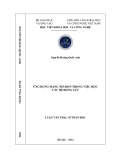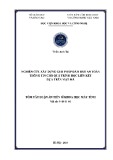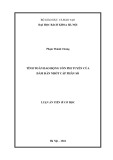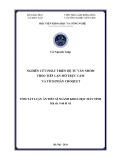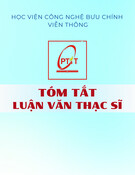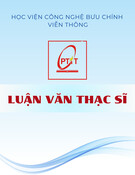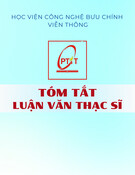
Annals of Mathematics
On the distribution of matrix
elements for the quantum cat
map
By P¨ar Kurlberg and Ze´ev Rudnick

Annals of Mathematics,161 (2005), 489–507
On the distribution of matrix elements
for the quantum cat map
By P¨
ar Kurlberg and Ze´
ev Rudnick*
Abstract
For many classically chaotic systems it is believed that the quantum wave
functions become uniformly distributed, that is the matrix elements of smooth
observables tend to the phase space average of the observable. In this paper we
study the fluctuations of the matrix elements for the desymmetrized quantum
cat map. We present a conjecture for the distribution of the normalized matrix
elements, namely that their distribution is that of a certain weighted sum
of traces of independent matrices in SU(2). This is in contrast to generic
chaotic systems where the distribution is expected to be Gaussian. We compute
the second and fourth moment of the normalized matrix elements and obtain
agreement with our conjecture.
1. Introduction
A fundamental feature of quantum wave functions of classically chaotic
systems is that the matrix elements of smooth observables tend to the phase
space average of the observable, at least in the sense of convergence in the mean
[15], [2], [17] or in the mean square [18]. In many systems it is believed that in
fact all matrix elements converge to the micro-canonical average, however this
has only been demonstrated for a couple of arithmetic systems: For “quantum
cat maps” [10], and conditional on the Generalized Riemann Hypothesis1also
for the modular domain [16], in both cases assuming that the systems are
desymmetrized by taking into account the action of “Hecke operators.”
As for the approach to the limit, it is expected that the fluctuations of the
matrix elements about their limit are Gaussian with variance given by classical
*This work was supported in part by the EC TMR network “Mathematical aspects of
Quantum Chaos” (HPRN-CT-2000-00103). P.K. was also supported in part by the NSF
(DMS-0071503), the Royal Swedish Academy of Sciences and the Swedish Research Council.
Z.R. was also supported in part by the US-Israel Bi-National Science Foundation.
1An unconditional proof was recently announced by Elon Lindenstrauss.

490 P¨
AR KURLBERG AND ZE´
EV RUDNICK
correlations of the observable [7], [5]. In this note we study these fluctuations
for the quantum cat map. Our finding is that for this system, the picture is
very different.
We recall the basic setup [8], [3], [4], [10] (see §2 for further background and
any unexplained notation): The classical mechanical system is the iteration of
a linear hyperbolic map A∈SL(2,Z) of the torus T2=R2/Z2(a “cat map”).
The quantum system is given by specifying an integer N, which plays the role
of the inverse Planck constant. In what follows, Nwill be restricted to be a
prime. The space of quantum states of the system is HN=L2(Z/N Z). Let
f∈C∞(T2) be a smooth, real valued observable and OpN(f):HN→H
Nits
quantization. The quantization of the classical map Ais a unitary map UN(A)
of HN.
In [10] we introduced Hecke operators, a group of commuting unitary
maps of HN, which commute with UN(A). The space HNhas an orthonormal
basis consisting of joint eigenvectors {ψj}N
j=1 of UN(A), which we call Hecke
eigenfunctions. The matrix elements OpN(f)ψj,ψ
jconverge2to the phase-
space average
T
2f(x)dx [10]. Our goal is to understand their fluctuations
around their limiting value.
Our main result is to present a conjecture for the limiting distribution of
the normalized matrix elements
F(N)
j:= √NOpN(f)ψj,ψ
j−
T
2
f(x)dx.
For this purpose, define a binary quadratic form associated to Aby
Q(x, y)=cx2+(d−a)xy −by2,A=ab
cd
.
For an observable f∈C∞(T2) and an integer ν, set
f#(ν):=
n=(n1,n2)∈
Z
2
Q(n)=ν
(−1)n1n2
f(n)
where
f(n) are the Fourier coefficients of f. (Note that f#can be identically
zero for nonzero f, e.g., if f=g−g◦A.)
Conjecture 1. As N→∞through primes,the limiting distribution of
the normalized matrix elements F(N)
jis that of the random variable
Xf:=
ν=0
f#(ν) tr(Uν)
2For arbitrary eigenfunctions, that is ones which are not Hecke eigenfunctions, this need
not hold, see [6].

MATRIX ELEMENTS FOR QUANTUM CAT MAPS 491
where Uνare independently chosen random matrices in SU(2) endowed with
Haar probability measure.
This conjecture predicts a radical departure from the Gaussian fluctua-
tions expected to hold for generic systems [7], [5]. Our first result confirms this
conjecture for the variance of these normalized matrix elements.
Theorem 2. As N→∞through primes,the variance of the normalized
matrix elements F(N)
jis given by
1
N
N
j=1 |F(N)
j|2→E(X2
f)=
ν=0 |f#(ν)|2.(1.1)
For a comparison with the variance expected for the case of generic sys-
tems, see Section 6.1. A similar departure from this behaviour of the variance
was observed recently by Luo and Sarnak [12] for the modular domain. For
another analogy with that case, see Section 6.2.
We also compute the fourth moment of F(N)
jand find agreement with
Conjecture 1:
Theorem 3. The fourth moment of the normalized matrix elements is
given by
1
N
N
j=1 |F(N)
j|4→E(|Xf|4)
as N→∞through primes.
Acknowledgements. We thank Peter Sarnak for discussions on his work
with Wenzhi Luo [12], and Dubi Kelmer for his comments.
2. Background
The full details on the cat map and its quantization can be found in [10].
For the reader’s convenience we briefly recall the setup: The classical dynamics
are given by a hyperbolic linear map A∈SL(2,Z) so that x=(p
q)∈T2→ Ax
is a symplectic map of the torus. Given an observable f∈C∞(T2), the classical
evolution defined by Ais f→ f◦A, where (f◦A)(x)=f(Ax).
For doing quantum mechanics on the torus, one takes Planck’s constant to
be 1/N and as the Hilbert space of states one takes HN:= L2(Z/N Z), where
the inner product is given by
φ, ψ=1
N
QmodN
φ(Q)ψ(Q).

492 P¨
AR KURLBERG AND ZE´
EV RUDNICK
The basic observables are given by the operators TN(n), n∈Z2, acting
on ψ∈L2(Z/N Z) via:
(TN(n1,n
2)ψ)(Q)=eiπn1n2
Nen2Q
Nψ(Q+n1),(2.1)
where e(x)=e2πix.
For any smooth classical observable f∈C∞(T2) with Fourier expansion
f(x)=n∈
Z
2
f(n)e(nx), its quantization is given by
OpN(f):=
n∈
Z
2
f(n)TN(n).
2.1. Quantum dynamics. For Awhich satisfies a certain parity condi-
tion, we can assign unitary operators UN(A), acting on L2(Z/N Z), having the
following important properties:
•“Exact Egorov”: For all observables f∈C∞(T2)
UN(A)−1OpN(f)UN(A)=Op
N(f◦A).
•The quantization depends only on Amodulo 2N:IfA≡Bmod 2N
then UN(A)=UN(B).
•The quantization is multiplicative: if A, B are congruent to the identity
matrix modulo 4 (resp., 2) if Nis even (resp., odd), then [10], [13]
UN(AB)=UN(A)UN(B).
2.2. Hecke eigenfunctions. Let α,α−1be the eigenvalues of A. Since A
is hyperbolic, αis a unit in the real quadratic field K=Q(α). Let O=Z[α],
which is an order of K. Let v=(v1,v
2)∈O2be a vector such that vA =αv.If
A=ab
cd
, we may take v=(c, α −a). Let I:= Z[v1,v
2]=Z[c, α −a]⊂O.
Then Iis an O-ideal, and the matrix of αacting on Iby multiplication in the
basis v1,v
2is precisely A. The choice of basis of Igives an identification I∼
=Z2
and the action of Oon the ideal Iby multiplication gives a ring homomorphism
ι:O→Mat2(Z)
with the property that det(ι(β)) = N(β), where N:Q(α)→Qis the norm
map.
Let C(2N) be the elements of O/2NOwith norm congruent to 1 mod 2N,
and which congruent to 1 modulo 4O(resp., 2O)ifNis even (resp.,odd).
Reducing ιmodulo 2Ngives a map
ι2N:C(2N)→SL2(Z/2NZ).




